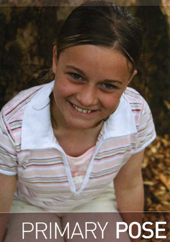| Primary Pose Kids Life, Issue 6, Oct-Nov 2004 By Jane Wiesner |
 Download Adobe Reader |
 Download this article as a PDF (870 KB) |
Can the magic of yoga create a happy, healthy child? Common sense tells us that for a person to be happy and healthy they need to have emotional strength and physical stamina. Primary teachers strive to help children develop these attributes by continually enhancing their teaching strategies, just as parents try to learn as much as they can about successful parenting. But teaching the young is not easy. In our world, children can be exposed to the complexities of adult problems at a very early age. I was one such child.
For me, growing up was an arduous journey. My mum had a breakdown after the loss of her husband (my dad died when I was seven) and I virtually took on the role of the parent in our household. I was the one who put my mum to bed when she drank too much. At seven, I became her protector and nurturer. As a consequence, I found life a lot more serious than the average seven-year-old would. Needless to say, my learning ability was impaired and as a result my self-esteem suffered. When I look back, I can see how desperately I needed to find an inner strength and awareness; a sense of self-worth. But my insecurities made it virtually impossible. Inevitably, my teenager years were wrought with rebellion. And my rebellion led me into perilous situations. When I was sixteen, I was faced with a choice between drugs and meditation. Thankfully, I chose meditation. For me, yoga was my saviour. It gave me an inner strength and sense of purpose.
As a teacher or parent, you have the chance to help shape young lives. By sharing the joys of yoga with children, you can teach them to develop positive life skills. Guided by your insight and wisdom, they can learn the art of living well by experiencing the benefits of exercise and stress management. How, you say? Let me explain it this way. All of us have basic needs that must be fulfilled in order to stay alive and maintain optimal health. Yogic theories strive to teach us ways to fulfil these needs. Yoga emphasises quality of life; distinguishing between a difficult existence of worry and insecurity and a life filled with hope, vitality and purpose.
Yoga comes from an ancient custom that dates back thousands of years in the Hindu culture. Yogic tradition is so broad that its limbs reach out in many directions. One branch, Hatha yoga, is defined as 'physical' yoga. In essence, Hatha yoga relates to the movement or flow of energy (life-force or prana) in the body. For example, through slow and steady movement and accompanying breathing techniques, the flow of prana is enhanced and our ability to deal with stress is heightened. Hatha yoga helps the body to switch from the sympathetic division of the autonomic nervous system (the fight or flight response) to the parasympathetic division of the autonomic nervous system (the relaxation state) with ease.
We are all primarily energetic beings - we need nutrients and stimulation in order to function properly.
The energy and information young people need to thrive can come in many forms. Whether a child develops positive health skills or negative, unhealthy habits, comes down to the information they receive and how they interpret that information. Yoga provides a subtle way to introduce a healthy lifestyle to the young, to guide them to positive choices.
Yoga practice works to promote focus. But when teaching yoga to the young, it is important not to be rigid or preoccupied with perfection. Yoga is not about being perfect in the pose, it is about being comfortable and steady in the pose. The more self-assured a person becomes, the more capable and effective they can become in all facets of life. In other words, it's important not to push children to think that they have to be infallible. As Aristotle taught, people become wise and self-confident when they understand that no one is perfect. To me, this is the essence of yoga. It teaches self-acceptance and love while at the same time building strength and stamina.
So how do you go about introducing your youngsters to yoga? Firstly, you need to read as much as you can about the subject, remembering that when in doubt, always go softly. Yoga practice is about gradually bringing integrity to the poses, but this doesn't happen immediately. The idea is to stretch and tone the body in simple, easy movements, accentuating a long spine and a relaxed neck and head. The poses should be gentle, not stiff, especially for beginners. Breathing techniques don't need to be emphasised when teaching the young. They can be slowly introduced as they child matures but not in a way that is too controlled. It's important for them not to become too preoccupied with the breath. It is also essential for children not to get too caught up with logistics - let their breath be natural with the occasional theatrical outward breath for fun. As the child grows, the breath will naturally become more focused.
When teaching children, it is important to remember the ways in which they learn. Psychologist and education consultant Marcella Reiter explains that we have three modes of learning - visual, auditory and kinetic. Some of us learn best by sight, others by hearing and others by touching and feeling. Generally, teachers today apply this concept to their teaching methods. When teaching yoga it is a good idea to do so in a way that explores all of these styles of learning. You could, for example, read my book, Who I am? a couple of times before attempting the poses - either in class or at home. When the child is suitably interested, allow the reading to naturally inspire questions regarding the pictures, then talk the child through the pose and let him/her experience the movement. After the practice, talk about how they feel. Over time, the child will become more in tune with their body. It is also a good idea to use affirmations during the practice, for example, 'I am as strong as a diamond'. Encourage the child to quietly say it aloud. Always remember that even though yoga is a form of exercise, first and foremost when applied to children, it is 'play'.
For further stimulation, the book can be used to identify colours (i.e. which colour do you see more than others in this picture?'). The text can be used to discuss feelings, e.g. 'How do we feel when we are playful? What does brave feel like?' In yoga poses, feelings relate to an action. The warrior pose can inspire a feeling of being brave, proud, strong. When the child makes a connection to the feeling, the feeling can become associated with the pose. As the child grows, this can be a valuable tool at time when they might feel uncertain or confused - the pose can be used to introduce a sense of peace and strength.
The most important thing to remember, no matter what age the child, is to promote fun, but in a gently calming way. Happiness is a feeling that sometimes becomes buried under the harshness of expectations. Think of yoga like theatre: it's a way to create enchantment. The most important thing yoga can teach us is to 'be in the moment'. We all know the saying that life is not a dress rehearsal. And, in our unstable world, the idea of making every minute count has become even more meaningful. Yoga is the 'magic' that can stop the clock. Use it as your magic wand in the classroom or at home.
See also:
- Yuga
- Ahimsa—The Art of Peace
- Yoga for Little People
- More Words, Less Truth
- The Risk of Demanding No Risk: The Hypocrisy of Justifiable Principles
- Controlling Chaos
- Iniquitous Virtue: The Trials of Virtue in a Global Society
- A Sporting Chance
- Free Joy: Enquire Within
- Happy Thoughts
- Notes from a Yoga Student: Yoga Heals
- Emotional Empowerment
- The Joy Child
- Mind Games
- Child's Pose


